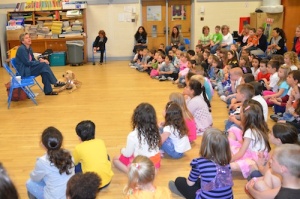How come the character with the disability never tells the story?
by Beth
I escaped from the snow and ice of Chicago late last month to attend the Association of Writers and Writing Programs (AWP) conference in Seattle. AWP is a huge conference – over 700 exhibitors, and sessions covering everything from “Lives Not Our Own: The Ethics and Practice of Assuming the Voices of Others” to “Four Ways Blogging Benefits a Writer.” The thing that really caught my attention were the tons of sessions about diverse writers and characters, sessions on things like “Weaving Stories from Strands of Truth: Native Writers on Nonfiction” and “Literary Politics: White Guys and Everyone Else.” All those sessions about race, gender and sexual orientation, but not a single one about writers who have disabilities, or concerning books with characters who have disabilities. Hmm.
Not much time to ponder how I feel about all that, though. I had to get ready for my trip to Long Island. That’s where I am now, spending three days visiting elementary schools with my Seeing Eye dog. That’s my Seeing Eye dog and me and first-graders on a previous visit to Long Island. My children’s book Hanni and Beth: Safe & Sound is about life with a Seeing Eye dog, and it got some attention after winning a Henry Bergh children’s book award from the American Society for the Prevention of Cruelty to Animals (ASPCA). I don’t think that’s the reason faraway teachers ask me to come visit their classrooms with my Seeing Eye dog, though.
That’s my Seeing Eye dog and me and first-graders on a previous visit to Long Island. My children’s book Hanni and Beth: Safe & Sound is about life with a Seeing Eye dog, and it got some attention after winning a Henry Bergh children’s book award from the American Society for the Prevention of Cruelty to Animals (ASPCA). I don’t think that’s the reason faraway teachers ask me to come visit their classrooms with my Seeing Eye dog, though.
The truth is, I don’t have much competition. There just aren’t a whole lot of children’s books focusing on characters who have disabilities. Educators from Brigham Young University (BYU) published a study in the journal Education and Training in Autism and Developmental Disabilities that found the representation of characters with disabilities is not proportionate to the current U.S. population of students with disabilities. From a BYU press release:
Along with an inaccurate representation of students with disabilities, the study also found a concerning theme of elimination of the characters with disabilities through death, being sent away or a discovery of a miraculous cure. In most cases, the character with the disability did not tell the story, and was often used in supporting roles that facilitated the emotional growth of other characters.
That last bit had me rethinking one of my favorite books reviewed here on the Easter Seals blog. Cynthia Lord’s “Rules” is an award-winning fictional children’s book that looks at autism, but sure enough, it’s written from the perspective of the older sister, not the boy with autism. The character with the disability is the supporting character, used to boost the emotional growth of his sister.
Let’s hope this study serves as a wake-up call to children’s book authors and publishers. I suppose I shouldn’t be asking for competition, but I look forward to more children’s books that focus on characters with disabilities. My visits to classrooms across the country show me that young readers love learning directly from people with disabilities about who we are and what we can do.







March 15th, 2014 at 2:56 pm
Good stuff
March 14th, 2014 at 8:20 am
While I agree that there are a limited number of books out there written from a disabled child’s point of view, there are more than you think. The Joey Pigza series by Jack Gantos and the Hank Zipzer series by Henry Winkler are first-person humorous stories about the main character’s ADHD. There are several about hearing impairment, including A Screaming Kind of Day by Rachna Gilmore. Wonder, by R.J. Palacio, is about, and told by, a child with a severe facial deformity. The Thing about Georgie, by Lisa Graff, is told by Georgie, who has dwarfism.
Having grown up with a hearing impairment and later, having worked with disabled teens and adults as a rehabilitation counselor has made me very aware of resources for children with disabilities, now that I am a children’s librarian. I have a bibliography of books about disabilities, which I would be happy to share. It contains books we own at my library, is by no means exhaustive, and, yes, most are written from others’ point of view.